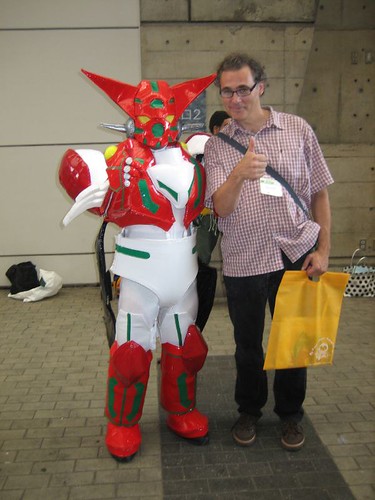 Players of Second Life know about the prim garbage problem. Within a few limits, players can fill up any land they own with objects created with 3D primitives, or prims. Over the years, this has resulted in a boom town jumble of buildings and objects. And a lot of junk.
Players of Second Life know about the prim garbage problem. Within a few limits, players can fill up any land they own with objects created with 3D primitives, or prims. Over the years, this has resulted in a boom town jumble of buildings and objects. And a lot of junk.
Tour through the world and it’s not long before you discover empty, windblown projects that appear abandoned to the timeless freeze of computer memory—static snapshots of the last time anyone cared to add, arrange or remove in-world geometry. Sure, in the virtual world this doesn’t attract pests and vermin looking to nest in the mess. And it doesn’t smell. But litter of objects creates a sort of visual clutter of real world garbage that under any other circumstances ought to be cleaned up.
Recently I spoke to a couple of active SL residents about the increase in in-world garbage. They admitted that the problem was continuing to grow as people just lost interest in their property and didn’t bother to tidy things up. And, SL being a pretty libertarian place, you can pretty much store old cars in piles and burn tires in your yard indefinitely, if you want to.
So what to do?
In the real world, this is exactly the sort of thing that urban planners deal with. Urban planning, in a very compressed sense, stems from the public’s interest in private property. So, the government can tell you that you cannot build a 120 foot tower in your backyard and that you can’t, in fact, burn tires in your yard. While the system is set up to recognize your private property rights, it also expresses a public interest in preserving the character of the neighborhood, the property values of the homes around you and keeping burning tire smoke pollution to a minimum.
Take this logic back into SL and you can see the problem. SL has lots of private property, but very little public interest.
You can scan the software world’s Community Standards and you’ll find the full extent of the public interest expressed in terms the given limits to your personal liberty in world:
1. Intolerance
2. Harassment
3. Assault
4. Disclosure
5. Indecency
6. Disturbing the Peace
No mention, of course of garbage. And very little of this actually deals with public interest in private property per se, but rather focuses on individual behavior.
So what to do about the SL garbage problem? The simple answer is to include some sort of public interest in all that virtual world private property.
Impossible? Improbably? Hardly.
In fact, once it’s pointed out, this is exactly how other worlds do it. World of Warcraft, for instance, works as a sort of progressive Marxist state. You can act in the world, and own property, but only as the “state†allows. Blizzard ultimately owns all the property (including, not incidentally, your avatar) and can do as they feel is necessary to manage the world in the best direction, as determined by its governors (or as we like to call them, the developers).
Star Wars Galaxies runs on a property model similar to WOW (you don’t really own anything). It took an interesting step to clear abandoned buildings by adding “urban renewal†to the Star Wars narrative. The developers announced an in-world event where the Empire used TIE Fighters to bomb unused property into a flattened building plots for resettlement of immigrants into the game. The use Star Wars lore suited the tenuous position of property in the game world—that you might squat on a plot of land, but it’s at the pleasure of the Empire. And when they want something, they can take it from you! In a sense, no private property. But lots of public interest.
How could SL handle its garbage problem from an urban planning perspective? There are many solutions, some obvious, some not and more than a few that are just technical (if game objects actually aged, without maintenance they would dissolve and disappear, for instance). But most of the planning intervention available all assumes that there is some public interest.
I’ve heard of covenant controlled communities in SL, and this is a perfect example of expressing a public interest while still allowing for private property. You can buy property in these communities, from the community, but then you have to abide by whatever building rules they set. Cleaning up your junk is one easy one. Linden Labs could zone their grid, requiring different types of building rules and clean up timeframes. A system of litter courts could hear appeals from citizens who think that a landowner should either clean up or pack up, and more.
What I make out of this is that while SL has worked to become a virtual world or community, it’s still more of an anarchists’ gathering. I hear people talking about SL as a year-around Burning Man. But Burning Man has all kinds of public interest. The entire temporary city is based around the notion of community responsibility. So, no, SL is no Burning Man.
But it could be.
SL residents need to address the idea of the public. The world needs to find an expression of that in the Terms of Service, in the Community Standards and even in the code. Until then, it will be a digital low point that continues to collect virtual trash.
 Players of Second Life know about the prim garbage problem. Within a few limits, players can fill up any land they own with objects created with 3D primitives, or prims. Over the years, this has resulted in a boom town jumble of buildings and objects. And a lot of junk.
Players of Second Life know about the prim garbage problem. Within a few limits, players can fill up any land they own with objects created with 3D primitives, or prims. Over the years, this has resulted in a boom town jumble of buildings and objects. And a lot of junk.

 Like a lot of people, I spent a lot of my summer in pursuit of leisure. And like a lot of people I visted Las Vegas.
Like a lot of people, I spent a lot of my summer in pursuit of leisure. And like a lot of people I visted Las Vegas. I could leave this as some sort of hand-handed capitalist parable. But what really got me thinking was that, in fact, while this is a very obvious illustration of the excess of Western Capital Culture, it is also a pretty good example of something that’s been bugging me about videogames.
I could leave this as some sort of hand-handed capitalist parable. But what really got me thinking was that, in fact, while this is a very obvious illustration of the excess of Western Capital Culture, it is also a pretty good example of something that’s been bugging me about videogames.